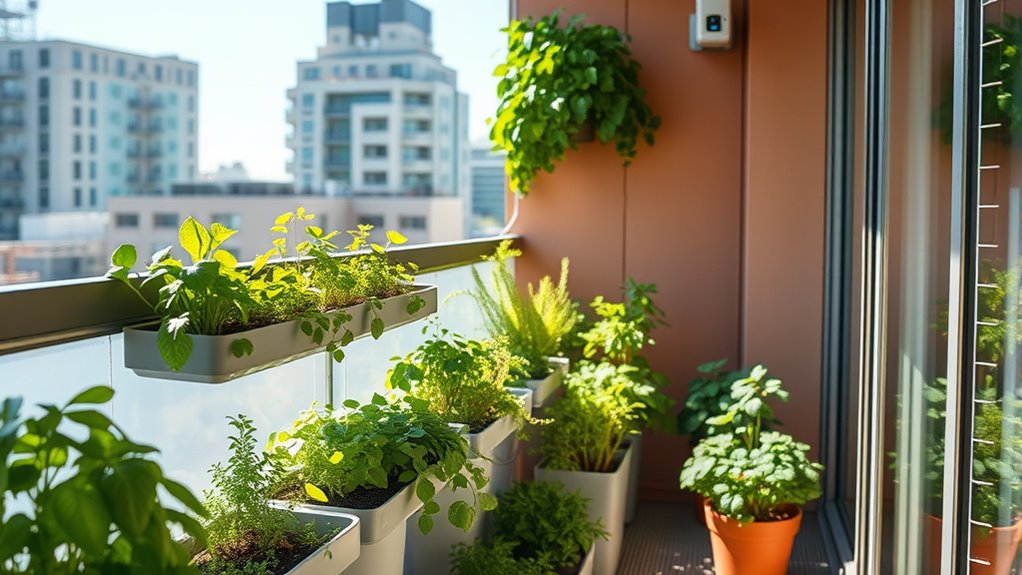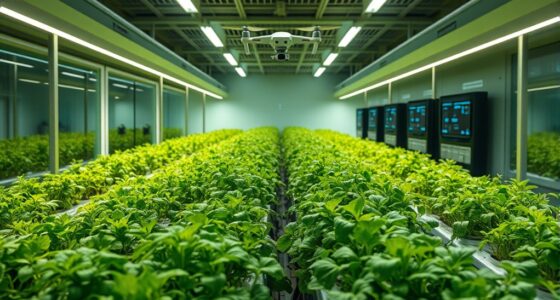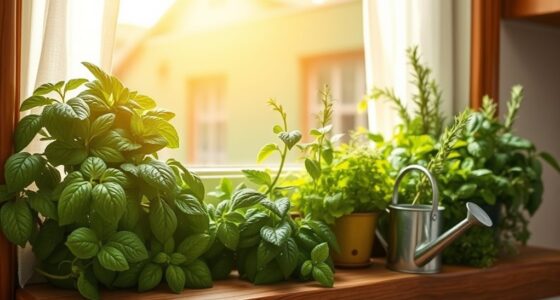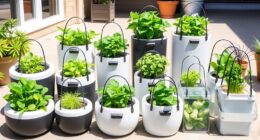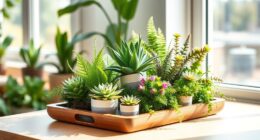To maximize your small apartment space, incorporate smart gardening solutions like vertical gardens, compact container setups, and balcony rail planters for easy access. Use multi-tiered stands and indoor hydroponic systems to grow plants year-round without clutter. Automate watering with self-watering planters and optimize light with integrated lighting. Focus on eco-friendly practices like composting and native plants to create a sustainable green space. Keep exploring for more tips on transforming your apartment into a lush oasis.
Key Takeaways
- Utilize vertical gardens, wall-mounted planters, and hanging gardens to maximize limited wall and ceiling space.
- Implement compact, modular container gardens for herbs and vegetables, optimized for small containers and easy maintenance.
- Incorporate smart, self-watering planters with app connectivity to reduce watering effort and ensure plant health.
- Use multi-tiered stands, balcony rail planters, and integrated lighting to improve accessibility, visibility, and growth conditions.
- Adopt eco-friendly practices like composting, native plants, and rainwater harvesting to create sustainable, low-impact indoor gardens.
Vertical Garden Systems for Space-Saving Greenery

Have you ever wished for a lush garden but felt limited by small apartment spaces? Vertical garden systems make it possible to enjoy greenery without taking up much room. You can install wall-mounted planters or hanging pockets that maximize your walls, transforming blank surfaces into vibrant plant displays. Proper garden lighting enhances your vertical garden’s beauty and assures your plants get enough light, especially in low-light apartments. Additionally, vertical setups can help with pest control by increasing airflow and reducing dampness, which pests love. Regular maintenance and strategic placement keep pests at bay, maintaining a healthy garden. Incorporating sustainable gardening practices into your vertical garden can further improve plant health and reduce environmental impact. With vertical systems, you create a stunning green space that’s functional, space-efficient, and easy to care for, bringing nature right into your apartment.
Compact Container Gardens for Herbs and Vegetables
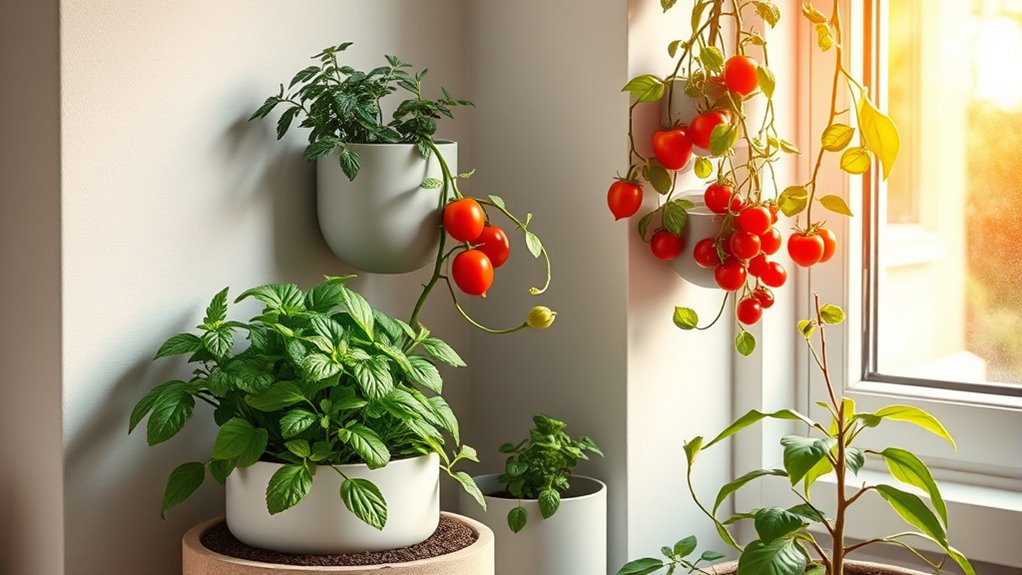
Creating a compact container garden is an ideal way to grow fresh herbs and vegetables in limited apartment spaces. Use small, lightweight containers with good drainage to maximize your space. Incorporate efficient composting techniques, like worm bins or kitchen scraps, to enrich your soil naturally. Regularly check for pests and manage them promptly with organic methods, such as neem oil or insecticidal soap, to keep your plants healthy. Rotate crops seasonally to prevent soil depletion and pest buildup. Keep your containers in sunny spots or under grow lights for maximum growth. Water consistently, ensuring the soil stays moist but not waterlogged. Implementing proper soil management techniques can further boost your garden’s productivity. This approach helps you enjoy fresh produce while maintaining a manageable, eco-friendly garden in your apartment.
Balcony Rail Planters for Easy Access and Visibility
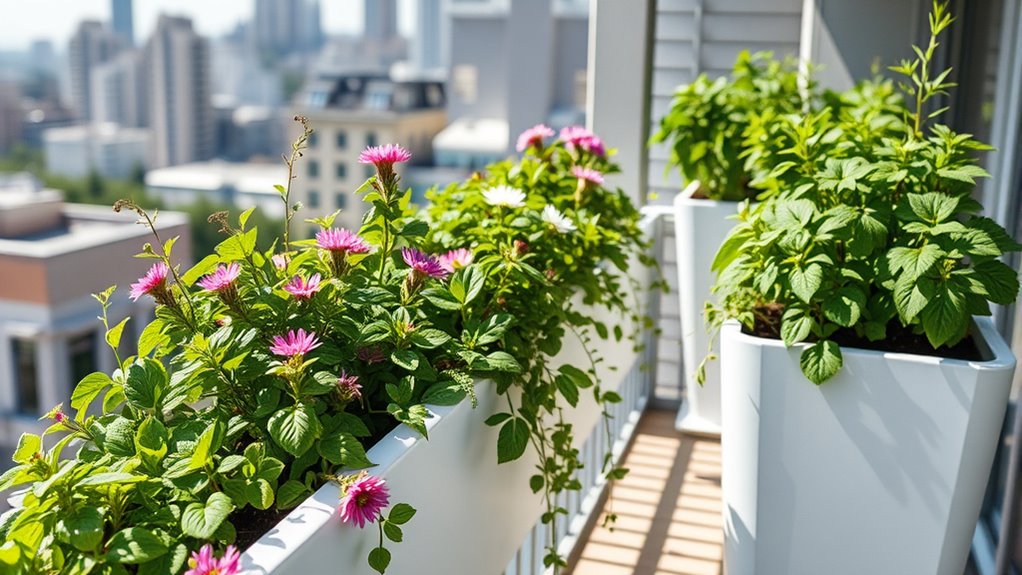
Balcony rail planters make gardening more accessible and convenient, so you can tend to your plants without bending or reaching awkward spots. Their placement also offers better visibility, allowing you to enjoy your garden from inside or outside. Plus, they add a charming touch to your balcony’s overall look.
Accessibility and Convenience
Balcony rail planters considerably enhance accessibility and convenience, making gardening more effortless for apartment dwellers. With these planters, you can easily tend to your plants without bending or reaching awkwardly, streamlining outdoor landscaping tasks. They keep your garden organized and within arm’s reach, reducing the need for ladders or stepping stools. Placing your plants at eye level also improves visibility, so you can monitor their health effortlessly. This setup integrates seamlessly with your existing garden furniture, creating a functional outdoor space. Plus, the convenience of accessible planters encourages regular watering and care, transforming your balcony into a well-maintained green retreat. Regularly assessing and rearranging items in your garden space can further optimize accessibility and ensure your plants thrive with less hassle. Overall, balcony rail planters simplify gardening, ensuring you enjoy your outdoor space with less effort.
Enhanced Visibility and Aesthetics
Because balcony rail planters are installed at eye level, they considerably enhance both visibility and aesthetics, allowing you to enjoy your garden from a comfortable vantage point. This improved view makes your small space feel more inviting and lively. To maximize visual appeal, consider adding garden lighting—solar or LED lights highlight your plants at night, creating a cozy atmosphere. Enhanced visibility also helps you spot pests early, making pest control easier and more effective. With your plants clearly in sight, you can quickly address issues before they spread. Additionally, plant placement plays a crucial role in achieving a balanced and attractive display. These planters keep your greenery accessible and attractive, turning your balcony into a stylish, functional oasis that’s both enjoyable and low-maintenance.
Multi-Tiered Plant Stands to Maximize Floor Space
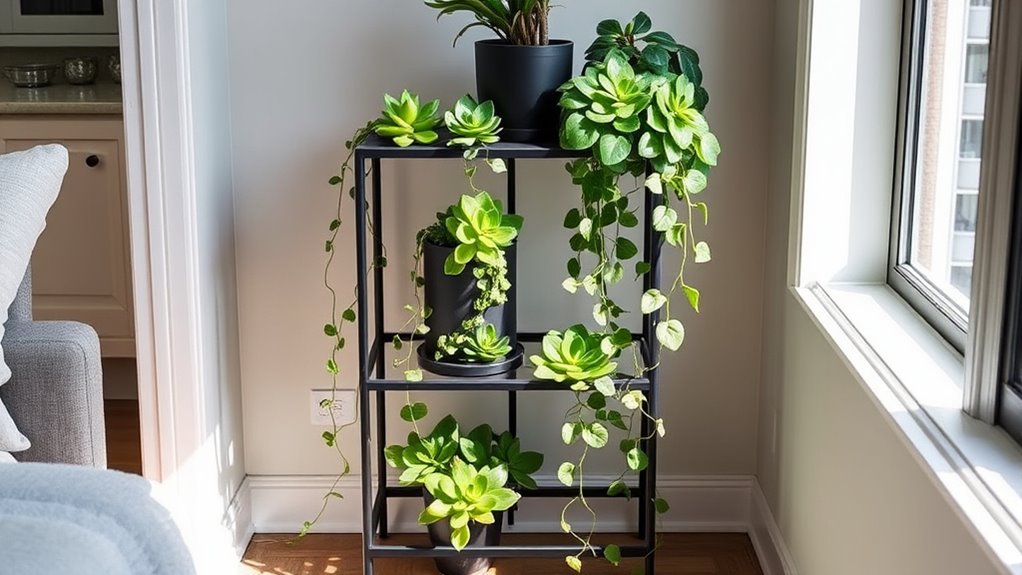
Multi-tiered plant stands help you make the most of limited floor space by stacking plants vertically. They come in versatile designs that fit various decor styles and allow easy access for watering and care. With simple maintenance features, these stands keep your garden neat and thriving without extra hassle. Additionally, choosing the right greenhouse components can enhance your small-space gardening setup for better growth and durability.
Space Optimization Techniques
To make the most of limited floor space in your apartment, multi-tiered plant stands are an excellent solution. They allow you to display more plants vertically, freeing up valuable floor area. When arranging your plants, consider companion planting; grouping compatible species can enhance growth and create a lush, organized look. This also helps with pest control by reducing the spread of pests between plants. Position taller plants on the top tiers and smaller ones below, optimizing light exposure and airflow. Use adjustable or stackable stands to customize your setup as your collection grows. These techniques maximize space efficiency while promoting healthy plants. With thoughtful placement and plant grouping, your small apartment garden becomes both functional and visually appealing, making the most of every inch available.
Versatile Design Options
Maximizing floor space in your apartment is easy with a variety of versatile, multi-tiered plant stands. These stands let you display multiple plants vertically, freeing up valuable surface area. They’re perfect for creating a lush, layered look without clutter. Plus, multi-tiered designs make garden composting easier by grouping plants that benefit from shared nutrients and waste management. They also help with pest control by keeping plants elevated and organized, reducing hiding spots for pests. You can choose options with adjustable shelves or stackable tiers to customize your setup. This flexibility allows you to adapt your garden as your plant collection grows or changes. Additionally, understanding family dynamics and cultural heritage can help you select plants and arrangements that reflect your personal or cultural identity. Overall, multi-tiered plant stands are a smart, space-efficient solution that elevates your apartment’s greenery while maintaining a tidy, functional space.
Easy Maintenance Features
Opting for plant stands with easy maintenance features can considerably simplify your gardening routine. Multi-tiered plant stands save floor space and make it easier to care for your plants. They often come with built-in options for integrated garden lighting, which reduces the need for extra setup and enhances plant health. Look for stands with removable trays or shelves for quick pest control and cleaning. Some designs include drainage systems that prevent overwatering, reducing plant stress. Additionally, adjustable heights allow you to optimize light exposure without rearranging everything. These features help you stay organized and efficient, making plant care less of a chore and more enjoyable. Be aware that free crypto opportunities like sign-up bonuses and referral programs can add value to your budget, freeing up more resources for your gardening projects. With easy access and smart design, your apartment garden remains neat, healthy, and low-maintenance.
Indoor Hydroponic Gardens for Year-Round Growth
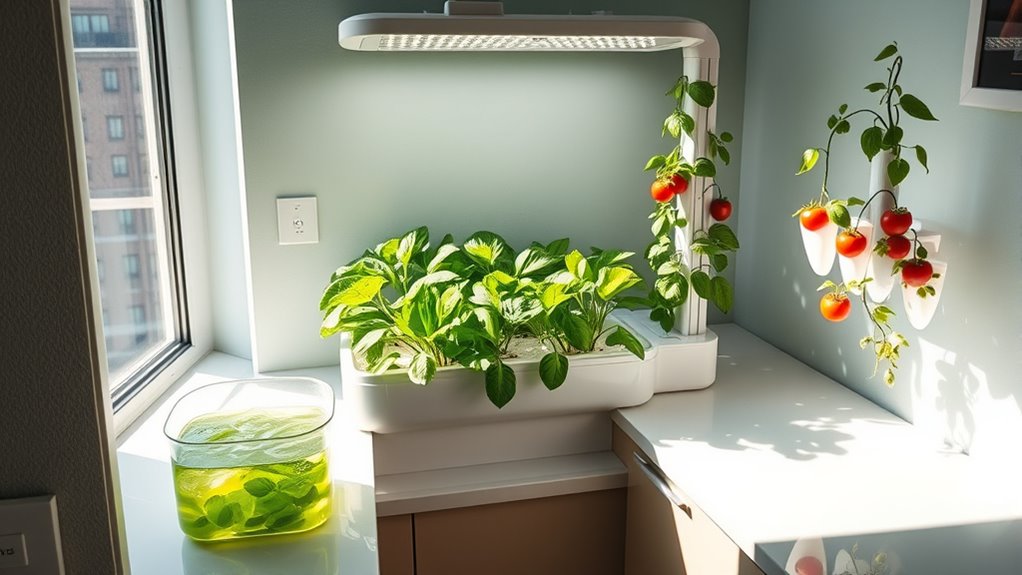
Indoor hydroponic gardens make it possible to grow fresh herbs and vegetables all year round, regardless of outdoor weather conditions. With controlled environments, you can optimize plant nutrition, ensuring your plants get the right nutrients without soil. This setup reduces the risk of pests, making pest management easier and more effective. Since there’s no soil, you avoid many common pests and diseases, meaning fewer chemicals or pesticides are needed. Plus, these systems often include adjustable lighting and nutrient delivery, supporting consistent growth. You’ll enjoy a continuous supply of herbs and greens, saving trips to the store. Hydroponic gardens also promote efficient water use, making them perfect for small spaces. Overall, they offer a reliable, low-maintenance solution for fresh produce year-round. Understanding the divorce process in Berlin can be helpful if you are considering legal separation and want to plan accordingly.
Smart Self-Watering Planters for Low-Maintenance Care
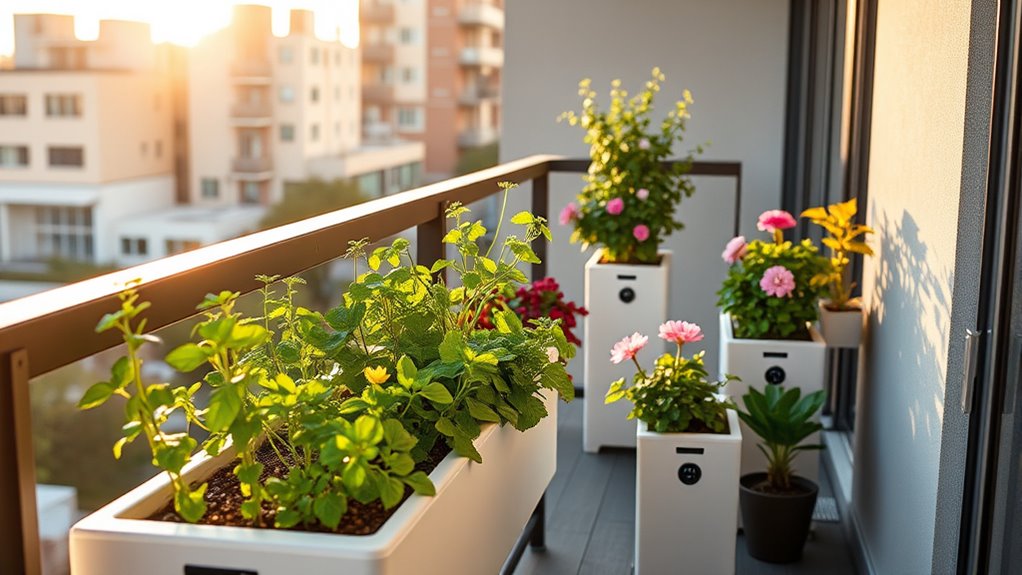
Smart self-watering planters simplify plant care by automatically providing the right amount of water, so you don’t have to remember to water regularly. These planters use soil moisture sensors to monitor soil health and trigger watering reminders when moisture levels drop too low. This prevents overwatering and underwatering, keeping your plants healthy with minimal effort. Many models also feature water level indicators, so you always know when to refill. Some planters connect to apps for real-time updates and customizable watering schedules. This technology makes maintaining your plants effortless, especially in busy schedules or small spaces. With smart self-watering planters, you can enjoy vibrant greenery without the constant worry about watering. They’re perfect for apartment dwellers seeking low-maintenance, hassle-free plant care. GMC tuning techniques can optimize watering systems to improve plant health and energy efficiency.
Hanging Gardens to Utilize Ceiling and Wall Space

Maximizing limited space in apartments often means getting creative with plant placement. Hanging gardens are perfect for utilizing ceiling and wall space, freeing up countertops and floors. You can install wall-mounted planters or suspended pots, creating a lush vertical display. To keep your plants thriving, guarantee proper garden lighting—consider grow lights or natural light sources nearby. This not only boosts growth but also simplifies pest management by giving you better visibility and easier access for inspection. Hanging gardens also reduce the risk of pests hiding in soil or on surfaces, making maintenance more straightforward. Incorporating easy-to-maintain materials can further streamline care and ensure your vertical garden remains vibrant with minimal effort. With these solutions, you turn unused vertical areas into vibrant, low-maintenance green spaces that brighten your apartment and optimize every inch.
Modular Garden Kits for Customizable Arrangements
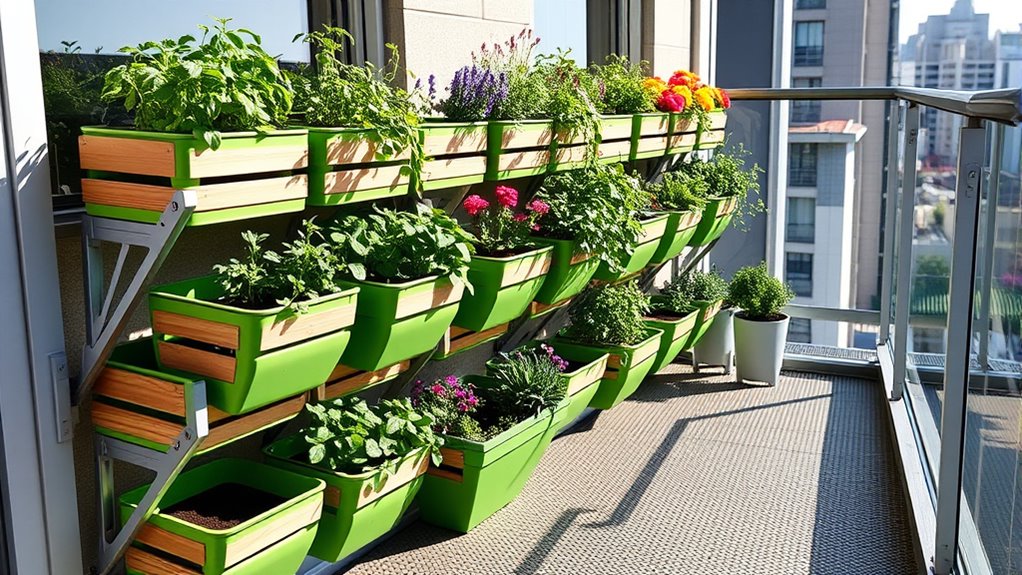
Have you considered how modular garden kits can customize your apartment’s green space? These kits allow you to create flexible, personalized arrangements that fit your space and style. With modular garden kits, you can easily add or rearrange sections as your needs change, making your garden truly unique. They’re perfect for small spaces, offering a variety of configurations to maximize your gardening potential. Plus, they’re simple to install and maintain, so you can enjoy your green oasis without hassle. Whether you prefer a lush herb corner or a colorful flower display, modular garden kits give you the freedom to design exactly what you want. You can also incorporate unique and wicked planters to elevate your indoor gardening experience with creative designs and materials.
Tips for Creating a Low-Impact, Eco-Friendly Garden Space
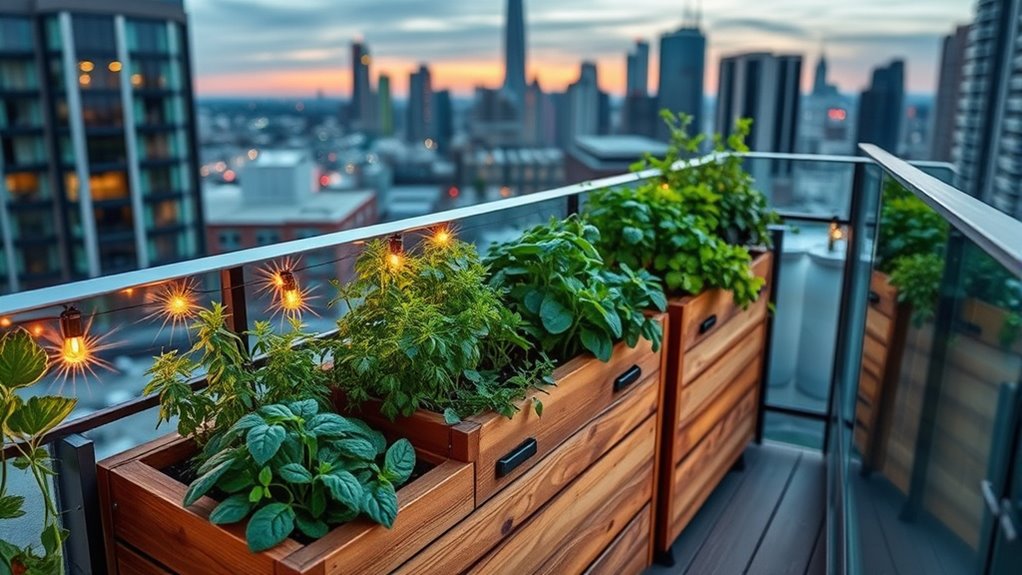
Creating a low-impact, eco-friendly garden starts with choosing sustainable practices that minimize harm to the environment. Start by adopting composting methods like worm bins or bokashi to recycle kitchen waste efficiently. Incorporate bee friendly plants such as lavender, thyme, or coneflowers to attract pollinators and support local ecosystems. Use organic soil and avoid chemical fertilizers to keep your garden safe for wildlife. Consider rainwater harvesting to reduce water usage and install native plants to thrive with less maintenance. Additionally, understanding the importance of contrast ratio can help you select the right lighting and color schemes for your garden space, enhancing its visual appeal and functionality. Here’s a quick guide:
| Sustainable Practice | Benefits |
|---|---|
| Composting methods | Reduces waste, enriches soil |
| Bee friendly plants | Supports pollinators, boosts plant health |
| Organic soil | Minimizes chemical runoff |
| Rainwater harvesting | Conserves water |
| Native plants | Thrive with minimal resources |
Frequently Asked Questions
How Do I Choose the Right Garden System for My Apartment Size?
To choose the right garden system, first consider your apartment size and available space. Think about garden system types that fit small areas like vertical gardens or compact hydroponic setups. Measure your space carefully and select a system that’s manageable and suits your needs. Keep in mind that larger apartments might accommodate more elaborate systems, while smaller spaces benefit from simple, space-efficient options. Your choice should maximize your gardening potential within your apartment’s limits.
What Are the Best Plants for Low-Light Indoor Gardens?
When selecting plants for low-light indoor gardens, you want resilient options like succulent varieties and air purifying plants. Succulents, such as aloe vera or jade plants, thrive with minimal light and require little water. Air purifying plants like pothos or snake plants also do well in low-light conditions, helping improve your indoor air quality. These choices keep your space vibrant and healthy, even without much sunlight.
How Often Should I Water and Fertilize My Small Garden?
Oh, you’re probably wondering if you need a secret watering schedule or a mysterious fertilization frequency, right? In reality, you should water your small garden when the top inch feels dry—about once every few days—and fertilize every 4-6 weeks with a balanced liquid fertilizer. Don’t overthink it; consistency is key. Keep an eye on your plants, and they’ll thrive without turning into a science experiment.
Can I Combine Different Gardening Systems for a Personalized Setup?
You can definitely combine different gardening systems to create a personalized setup. Modular systems make this easy, as they’re designed to fit together seamlessly. By mixing, say, hydroponic modules with container gardens, you tailor your space to suit your plants’ needs and your preferences. Just guarantee compatibility and proper maintenance, and you’ll enjoy a custom setup that maximizes your small space efficiently and beautifully.
What Safety Precautions Should I Consider for Indoor Gardening?
Pay attention to potential pitfalls with indoor gardening. First, prioritize electrical safety—avoid overloading outlets and keep cords away from water to prevent shocks. Second, practice pest prevention by maintaining cleanliness and inspecting plants regularly. Protect your space and plants by using proper containers and ensuring good airflow. These precautions keep your indoor oasis safe, sound, and sustainable, helping you enjoy lush greenery without unnecessary risks or pests.
Conclusion
Did you know that small-space gardens can reduce indoor air pollution by up to 50%? With smart solutions like vertical gardens and self-watering planters, you can transform your apartment into a lush oasis without sacrificing space. These ideas not only save room but also boost your well-being and eco-friendliness. Start small, get creative, and enjoy the fresh, green benefits every day—your perfect urban garden is within reach!
